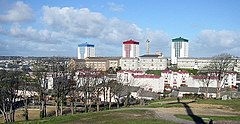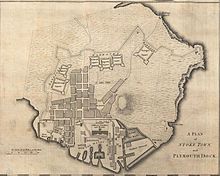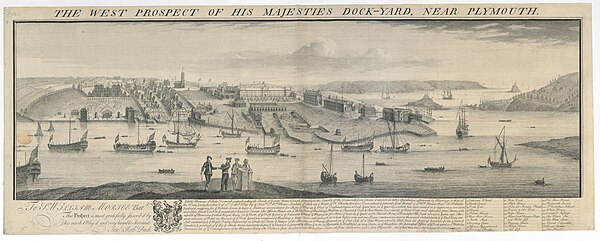Devonport, Plymouth
| Devonport | |
|---|---|
 Devonport skyline | |
Location withinDevon | |
| OS grid reference | SX455547 |
| Unitary authority | |
| Ceremonial county | |
| Region | |
| Country | England |
| Sovereign state | United Kingdom |
| Post town | PLYMOUTH |
| Postcode district | PL1 |
| Dialling code | 01752 |
| Police | Devon and Cornwall |
| Fire | Devon and Somerset |
| Ambulance | South Western |
| UK Parliament | |
Devonport(/ˈdɛvənpɔːrt/DEV-ən-port),[1]formerly namedPlymouth Dockor justDock,[2]is a district ofPlymouthin the English county ofDevon,although it was, at one time, the more important settlement. It became a county borough in 1889. Devonport was originally one of the "Three Towns"(along with Plymouth andEast Stonehouse); these merged in 1914 to form what would become in 1928 the City of Plymouth. It is represented in theParliament of the United Kingdomas part of thePlymouth Sutton and Devonport constituency.Its electedMember of Parliament (MP)isLuke Pollard,who is a member of theLabour Party.The population of the ward at the 2011 census was 14,788.[3]
History
[edit]Plymouth Dock
[edit]In 1690 the Admiralty gave a contract to Robert Waters from Portsmouth to build a stone dock at Point Froward on the east bank of theHamoazeat the mouth of theRiver Tamar.Plymouth Dock, as Devonport was originally called, began around 1700 as a small settlement to house workers employed on the new naval base that was being built around Waters' dock.[4]By 1733 its population had grown to around 3,000,[5]and by 1801 it was already larger than both the nearby towns of Plymouth and Stonehouse together.[6]
Devonport
[edit]By 1811 the population of Plymouth Dock was just over 30,000 and the residents resented the fact that its name made it sound like an adjunct of Plymouth. In 1823 a petition to King George IV requested the town should be renamed, and suggested "Devonport". The king agreed to the change of name, which took effect on 1 January 1824.[7][8]To celebrate, the town builtDevonport Columnnext to the recently completedguildhall;both were designed byJohn Foulston.[2]Devonport was first incorporated as amunicipal boroughin 1837 under theMunicipal Corporations Act 1835.
In July 1849, the first outbreaks in what became acholeraepidemic arose onUnion Streetwhich connected Plymouth to Devonport, and were initially attributed to blockage of several house drains during construction of a newMillbay railway station.[9][10]Devonport became acounty boroughunder theLocal Government Act 1888.In 1914 the county borough of Devonport was abolished, when it and the neighbouringurban districtofEast Stonehousewere absorbed into the county borough of Plymouth.[11]
Dockyard defences
[edit]
In the mid-eighteenth century a defensive earthwork was constructed around the town and dockyard. Within these dockyard 'lines', six square barracks were built between in 1758–63 to accommodate the garrison of troops required to man the defences.[12]A series ofredoubtswere also constructed, forward of the lines, in the 1770s, including that at Mount Pleasant (of which there are substantial remains).[13]In the early nineteenth century, the dockyard lines were strengthened with stone ramparts and armed with guns, and the adjacent ditches were deepened. These defences became largely redundant with the building of a series ofPalmerston Forts around Plymouthin the second half of the nineteenth century. Much of the open land forming theglacisbeyond the lines became Devonport Park in the late 1850s.[14]Three of the six small barracks were replaced in 1854–6 by the sizeableRaglan Infantry Barracks,designed by CaptainFrancis Fowke(who later designed theAlbert Hall); today only its gatehouse remains (and that in a derelict state), the rest having been demolished in the 1970s.[15]
Mount Wise
[edit]
The high ground south of the town is called Mount Wise. Enclosed within the town ramparts, it was given its own redoubt in the 1770s, with eight guns and two mortars protecting the coastal approach to the dockyard. In earlier times, agun wharfhad been established on the quayside here to the south-east; the gun wharf was removed (and re-established at Morice Yard alongside the Dockyard) in 1724, but the area remained dominated by the armed forces up until the present century. From the late-eighteenth/early-nineteenth century both themilitary Governorandnaval Commander-in-Chiefof Plymouth were accommodated in large houses on Mount Wise (inGovernment HouseandAdmiralty Houserespectively).[16]In 1805 aRoyal Laboratory(an outpost of theWoolwich Arsenal) was established just north-west of the redoubt;small-armsammunition and explosives were manufactured here, until the compound was converted into barracks accommodation (Mount Wise Barracks) in the 1830s.[17]
21st-century Devonport
[edit]During the millennium decade, Devonport received governmentNew Deal for Communitiesfunding of £48.7 million; this enabled an extensive Regeneration programme to be carried out. Since 2009, the investments have begun to transform Devonport – physically, socially, demographically. Where once the area was run-down, depressed, and classified as 'deprived' in many categories, the 21st-century Devonport is beginning to achieve the city's vision of... "The recreation of Devonport as a distinct place in modern Plymouth; a vibrant self sustaining community; a place of real quality, variety and interest, the pride of residents, attractive to visitors and a model of 21st Century living, working and playing."[18]
The Admiralty's release of several land plots in Devonport has assisted the Regeneration project. One ex-MoD area, where new homes will be available from 2011, is the Admiralty House site at Mount Wise. Although there are pockets of regeneration work remaining to be completed, the waterfront district of Devonport is becoming one of the desired residential areas of the city of Plymouth.[19]
In 2011, theDevonport Heritage Trailwas introduced, complete with over 70 waymarkers outlining the route.[20]
Facilities
[edit]Devonport has its own shopping street, arailway station,a swimming pool, park and a sports ground,The Brickfields.Since 2003, it has been the home ofPlymouth Albion,the city'sRugby unionclub located near Plymouth City College.
Devonport is also home to the Devonport Playhouse, atheatrelocated in the formerMethodist Central Hallin Fore Street. The space was purchased and converted into a performance venue by the Plymouth Theatre Company back in 1987.[21]It is a popular venue with the localAmateur Dramaticcompanies, choirs and dancing schools in Plymouth especially, since the closure ofthe Athenaeumin central Plymouth.[22]
UTC Plymouthis auniversity technical college(UTC) which opened in September 2013 nearDevonport Park.The UTC is situated on the former site of Parkside Community College,[23]which closed in August 2008 due to falling enrolment.[24]
TheTorpoint Ferryservice across theHamoaze(River Tamar) operates from Devonport to Cornwall.
Devonport Naval base/Dockyard has, over the years, been known as "Guz" bynaval ratings.There are various explanations for the nickname: theRoyal Naval Museumsays it is short forGuzzleand refers to Devoncream teas.[25]


- R. F. Scott (1968–1912, Antarctica) British naval officer and explorer, born Devonport, led the heroic but ill-fated second expedition in 1910 to reach the South Pole.[26]
- N. T. Carrington (1777–1830), schoolmaster and poet.[27]
- Charles Mathews,theatre manager and comic actor, lived here for several months before his death in 1835.
- Leslie Hore-Belisha, 1st Baron Hore-Belisha(1893–1957) was born in Devonport. In the 1945 general election he stood for the seat as a National Independent candidate, but was defeated byMichael Foot.In 1954 he was elevated to the peerage as Baron Hore-Belisha, of Devonport in the County of Devon.
- Ralph Alger Bagnold(1896–1990) was born here. He was a pioneer of desert exploration, and was the founder and first commander of the British Army's Long Range Desert Group. He also made significant contributions to the scientific understanding of desert structures.
- Guy Burgess(1911–1963), one of theCambridge Fivespy ring that betrayed Western secrets to the Soviets before and during the Cold War, was born here.
Charles Darwinspent two months in Devonport from October 1831 waiting for the weather to improve so thatHMSBeaglecould begin itsjourney to South America.The ship finally left on 27 December and Darwin later wrote that those two months were "The most miserable which I ever spent".[28]
References
[edit]- ^Upton, Clive;Kretzschmar, William A. Jr. (2017).The Routledge Dictionary of Pronunciation for Current English(2nd ed.). Routledge. p. 351.ISBN978-1-138-12566-7.
- ^abBridget Cherry & Nikolaus Pevsner (1989).The Buildings of England – Devon.Harmondsworth: Penguin. pp. 674–675.ISBN0-14-071050-7.
- ^"Ward population 2011".Retrieved15 February2015.
- ^Gill (1993), pp. 168–169.
- ^Gill (1993), p. 173.
- ^Gill (1993), p. 201 gives the figures as: Plymouth – 16,378; Stonehouse – 3,807; Dock – 23,787
- ^"Town Hall, Plymouth Dock, 26th Dec. 1823".Royal Cornwall Gazette.Truro. 3 January 1824. p. 3.Retrieved13 August2023.
...his Majesty has been graciously pleased to comply with the prayer of the said petition, and to direct that, on and after the 1st day of January next, the town of Plymouth-Dock shall be called and known by the name of Devonport...
- ^Gill (1993), p. 203.
- ^Hamilton, Dr. W. (1850).On the Vital Statistics of the Borough of Plymouth, in The London Medical Gazette Vol. XI.London: Longman, Brown, Green and Longmans. p. 614.(online atGoogle Books)
- ^Cholera in its Relations to Sanitary Measures, in The British and Foreign Medico-chirurgical Review.London: Samuel Highley. January 1851. p. 23.(online atGoogle Books)
- ^"Local Government Board's Provisional Order Confirmation (No. 18) Act 1914"(PDF).legislation.gov.uk.The National Archives.Retrieved30 December2023.
- ^Douet, James (1998).British Barracks 1600-1914.Swindon: English Heritage.
- ^Historic England."Scheduled Ancient Monument listing (1021287)".National Heritage List for England.Retrieved3 March2015.
- ^Historic England."Details from listed building database (1001657)".National Heritage List for England.Retrieved3 March2015.
- ^Historic England."Grade II listing description (1386244)".National Heritage List for England.Retrieved3 March2015.
- ^"Plymouth Maritime Headquarters (Mount Wise)".Retrieved21 November2015.
- ^"Devonport conservation q"(PDF).City of Plymouth.Archived fromthe original(PDF)on 26 August 2016.Retrieved23 August2016.
- ^"A framework for Change"(PDF).Plymouth City Council. Archived fromthe original(PDF)on 15 October 2012.Retrieved21 November2015.
- ^"Devonport Online".
- ^"Devonport Heritage Trail".Retrieved29 April2011.
- ^"Plymouth Theatre Company:: Devonport: Plymouth:: Plymouth's Independent Theatre Company".plymouththeatrecompany.com.Retrieved27 May2020.
- ^Limited, TicketSource."The Wind in the Willows at The Devonport Playhouse".ticketsource.co.uk.Retrieved27 May2020.
- ^"UTC Plymouth | University Technical College Plymouth | Parkside School Plymouth".Archived fromthe originalon 20 April 2013.Retrieved30 March2013.
- ^A joint statement by Plymouth City Council and Parkside Community CollegeArchived9 June 2011 at theWayback Machine
- ^"Pompey, Chats and Guz: the Origins of Naval Town Nicknames".Royal Naval Museum. Archived fromthe originalon 8 August 2011.Retrieved14 January2011.
- ^"Captain Robert Falcon Scott".
- ^"N. T. Carrington's poems".Copac.Retrieved13 December2009.
- ^"Darwin in Plymouth".Plymouth City Council.Retrieved29 August2012.
Sources
[edit]- .Encyclopædia Britannica.Vol. VII (9th ed.). 1878. pp. 138–139.
- Gill, Crispin (1993).Plymouth. A New History.Devon Books.ISBN0-86114-882-7.


